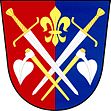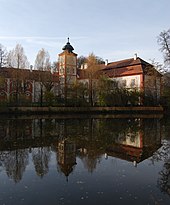Drahenice
| Drahenice | ||||
|---|---|---|---|---|
|
||||
| Basic data | ||||
| State : |
|
|||
| Region : | Středočeský kraj | |||
| District : | Příbram | |||
| Area : | 555 ha | |||
| Geographic location : | 49 ° 31 ' N , 13 ° 58' E | |||
| Height: | 495 m nm | |||
| Residents : | 152 (Jan 1, 2019) | |||
| Postal code : | 262 85 | |||
| License plate : | S. | |||
| traffic | ||||
| Street: | Březnice - Myštice | |||
| Railway connection: | Březnice – Strakonice | |||
| structure | ||||
| Status: | local community | |||
| Districts: | 1 | |||
| administration | ||||
| Mayor : | Jiří Trefný (as of 2012) | |||
| Address: | Drahenice 87 262 85 Drahenice |
|||
| Municipality number: | 599298 | |||
| Website : | www.drahenice.estranky.cz | |||
Drahenice (German Drahenitz ) is a municipality in the Czech Republic . It is located five kilometers south of Březnice and belongs to the Okres Příbram . Since 1995 the center of the village and the Račany village monument zone have been protected.
geography
Drahenice is located in the basin of the Drahenický brook in the Central Bohemian hill country . The Zámecký rybník pond is in the center of the village, the Hradčanský rybník and the Podleský rybník on the western outskirts and the Mlýnský drahenický rybník to the north. The Březnice – Strakonice railway runs northwest of the village . The Hora (500 m) and the Čihadlo (515 m) rise to the northeast, the Holý vrch (513 m) to the east, the Vrch svobody (521 m) to the southeast, the Drahenický vrch (615 m) to the south and the Stráž (northwest). 555 m) and the Hradec (531 m).
Neighboring towns are Simínský Mlyn, Drahenický Mlyn, Martinice, Počapelský Mlyn and Počaply in the north, Na Drahách, Lhotka, Ohař and Myslín in the Northeast, Holý Vrch, Podskalí and Plíškovice the east, Sochovice, Ráztely and Draheničky the southeast, Ostrov, Uzenicky and Stranohoří in the south, Hostišovice , Na Hůrce, Chaloupky and Podruhlí in the south-west, Koupě and Račany in the west and Slavětín and Hudčice in the north-west.
history
The first written mention of the fortress and two villages called Drahynice (Drahenice and Draheničky) took place in 1227. One part of Drahenice belonged to the Lords of Bresnitz on Březnice, the other part of the fortress. At the transition from the 14th to the 15th century, Jan Brus von Kovářov belonged to the owners, he is regarded as the father of the chronicler Bartošek von Drahenice (1390–1445). At the end of the 14th century the fortress was the seat of the Schütz von Drahenitz ( Šic z Drahenic ) men . Jan Šic was followed by his sons Jan and Albrecht, who later moved their headquarters to the Lazsko and Zalužany estates . Wenzel Drahenitzky von Rastel ( Václavu Drahenský z Rastel ) can be verified as the owner from 1492 . Johann Drahenitzky von Rastel sold the fortress and the village to Kerung Wrabsky von Wraby around 1536. He was followed by his brother Hynek, who in 1552 bought the Malkow estate ( Drahenický Málkov ). He bequeathed the rule to his sons Johann and Wilhelm, of whom the former managed the Drahenitz estate alone from 1571. Johann Wrabsky von Wraby bought the Uzenice estate in 1577 . Ursula Wrabsky von Bukowa bought the Draheniček estate from Christoph von Schwanberg on Worlik and Klingenberg in 1580 . In 1584 Johann's younger brother Wilhelm the Elder took over. Ä. Wrabsky Tluksa von Wraby and his wife Eva von Předenice took over the Drahenitz estate. The stately brewery was founded around 1600 and reached its heyday in the 18th century with an annual production of 4,000 hectoliters.
In 1617, Wilhelm acquired the Teutsch-Usenitz estate with the villages of Klein-Usenitz and Černisko . He was also able to expand the rule to include the Chrast farm and the Svučice estate. He had the Wrabsky family crypt built in the Stražiště church. The subsequent owners were his son Adam Ignaz ( Adam Hynek ) and his wife Elisabeth Polyxena von Kokořov, who also bought the Dešenice and Hostišovice estates . From 1662 Wenzel Rudolph Wrabsky Tluksa von Wraby followed and then Eva Maria Wrabsky, née Lažansky von Buggau. The latter bought the estate Dworetitz ( Dvořetice ) with the village Wahlowitz ( Vahlovice ) from the knights Sobietitzky von Sobietitz in 1673 .
In 1686 Eva Maria Wrabsky sold the rule to Leopold Wilhelm Reichsgraf von Waldstein . He was followed by Franz Karl Reichsgraf von Waldstein, then his widow Maria Ludmilla, née Kolowrat -Liebsteinský, who married Johann Wenzel von Sternberg for the second time in 1706 . In 1713 Drahenice consisted of 30 houses and 290 inhabitants. 1716 bought Maria Ludmilla from the knights Bieschin zu Bieschin the estate Swudschitz ( Svučice ) with Wostrow ( Ostrov ) and a share of Pohoř ( Pohoří ). After her death in 1720 her daughter Maria Franzisca von Waldstein inherited the rule. In 1784, their daughter Marie Elisabeth Countess von Nostitz-Rieneck , née Kolowrat-Krakowsky von Ugezd, inherited the property. In 1788 the castle chapel was raised to the status of the Mirowitz parish . The first school was established around 1790. In 1795 Marie Elisabeth von Nostitz-Rieneck sold the rule to Oberstlandmarschall Johann Prokop Graf Hartmann von Klarstein. He bought emphyteutically (leasehold) the iron hammer near Zawieschin with a blast furnace and three rod hammers from the rule of Schlüsselburg .
In 1840 the allodial rule Drahenitz comprised a usable area of 10,000 yoke 1166 square fathoms. 4036 mainly Czech-speaking people lived on their territory, including twelve Israelite families. The lordship managed five farms, four more were canceled. In addition, the rule maintained the Drahenitzer, Usenitschker, Chraster, Malkower, Hoschowitzer and Dworetitzer forest districts. To rule the villages Drahenitz, small Drahenitz or Draheniček (included Draheničky ) Swudschitz ( Svučice ) Swobodka ( Svobodka ) Wostrow ( Ostrov ) Weyschitz ( Výšice ) Kožlj ( Kožlí ) Černisko , Hoschowitz , Malkow ( Drahenický Málkov ), Usenitz , Klein-Usenitz , Podruhly , Hutschitz , Vorder-Pořschitz ( Přední Poříčí ), Hinter-Pořschitz ( Zadní Poříčí ), Chrast , Namnitz ( Namnice ), Latzina ( Laciná ) and Wahlowitz ( Vahlovice ) as well as eight houses from Rastel ( Ráztely ), seven houses including the church, parish and school in Pohoř ( Pohoří ) and a house in Počap . The village of Drahenitz consisted of 77 houses with 548 inhabitants, including four Israelite families. In Drahenitz there was a stately castle with the offices of the Oberamt, a brewery and a Brantweinhaus; The local church, the localist house and the school were under lordly patronage. A stately brick hut and a stately mutton farm lay apart. Drahenitz was the parish for Draheniček and Rastel. Until the middle of the 19th century, Drahenitz was the official village of the allodial rule Drahenitz.
After the abolition of patrimonial formed Drahenice / Drahenitz with Račany / Racan from 1850, a municipality in the district administration and the judicial district Breznitz. Since 1868 the municipality has belonged to the Blatná district. In 1870 Anna von Lobkowicz became the owner of the goods, followed in 1919 by her son Jan. The volunteer fire brigade was founded on March 8, 1896. Between 1897 and 1899 the railway was built. In 1911 520 people lived in the 88 houses in the village. On the occasion of the founding of Czechoslovakia in 1918, three trees of freedom were planted on the hill Výrovna, which was later named Vrch svobody . After only 720 hectoliters of beer had been brewed in 1923, the brewery ceased production in 1924. The connection to the electricity network took place in 1924. In 1930 the village consisted of 89 houses and had 469 inhabitants.
After the German occupation , the goods were placed under German administration, as Jan Lobkowicz had taken Czechoslovak citizenship in 1938. After the end of the Second World War he got his goods back and was expropriated again by the communists in 1948. Between 1950 and 1961 the castle and the courtyard served as garrison barracks, after which a military hospital was set up in the castle. In the course of the abolition of the Okres Blatná, Drahenice was assigned to the Okres Příbram in 1960. In 1970 Drahenice consisted of 94 houses with 283 inhabitants. The kindergarten was closed in 1971 due to the low number of children and in 1973 the 9-class Drahenice elementary school was also discontinued. In 1977 it was incorporated into Březnice . On November 24, 1990 Drahenice broke away from Březnice and formed its own community.
In 1992 Jan Lobkowicz's grandson got his grandfather's property back, except for the agricultural land that had been divided up between farmers in the area. He began with the management of forest and forest, bought back fields for cultivation, renovated the dilapidated castle and now lives in it with his family. In May 1995 the ensemble of folk architecture was declared a Drahenice Monument Reserve ( Památková rezervace Drahenice ) by the government of the Czech Republic . On September 22, 1995, the Ministry of Culture also designated the Drahenice-Račany Village Monument Zone ( Vesnická památková zóna Drahenice-Račany ). The former school was converted into a municipal office in 2000. The community has had a coat of arms and a banner since 2005. In 2006 the village had 180 inhabitants.
Community structure
No districts are shown for the municipality of Drahenice. Račany, also known as Hradčany ( Ratschan ), belongs to Drahenice .
Attractions
- Drahenice Castle with Castle Chapel and English Park. It was created at the transition from the 16th to the 17th century from the Gothic fortress. In 1638 Adam Ignaz Wrabsky received ecclesiastical permission to build a palace chapel. In 1992 the palace, which was nationalized in 1948, was returned to Johannes Lobkowicz and has been renovated since 1995. It is not open to the public and, next to Prague, is the residence of Johannes Lobkowicz.
- Church of the Immaculate Conception, it was built in 1792–1796 by expanding the castle chapel
- Ensemble of folk buildings in Drahenice and Račany
- Niche chapel at the school
- Memorial to the fallen of the First World War
- Wayside shrines in the Velké Račany and U Ovčína locations, they were repaired in 2009 with the support of Nadace VIA.
- Several wayside crosses
- Vrch Svobody with the Liberty Trees from 1918 and a monument unveiled in 1946
- French fire engine from 1807, it was bought from the Napoleonic troops by Johann Prokop Hartmann von Klarstein and given to the community. Today it belongs to the local fire brigade and is considered the oldest fire engine in the Czech Republic.
Personalities
- Bartošek z Drahenic (1390–1445), chronicler
Individual evidence
- ↑ Český statistický úřad - The population of the Czech municipalities as of January 1, 2019 (PDF; 7.4 MiB)
- ^ Johann Gottfried Sommer The Kingdom of Bohemia, Vol. 8 Prachiner Kreis, 1840, pp. 84-90
Web links
- Presentation Drahenice 780 years 1227–2007 (PDF; 2.5 MB)




